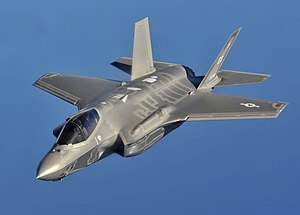Z-17 Condor
| Z-17 Condor | |
|---|---|
 | |
| General information | |
| Type | Multirole |
| Manufacturer | Toring Industries |
| Status | Active service |
| History | |
| Introduction date | 15 October 2016 |
The Toring Industries Z-17 Condor is a single-seat, single-engine, all-weather stealth tactical multirole combat aircraft developed for the Zamastanian Air Force (ZDAF) intended to perform both air superiority and strike missions. It is also able to provide electronic warfare and intelligence, surveillance, and reconnaissance capabilities. The prime contractor, Toring Industries, built most of the Z-17's airframe and weapons systems and conducted final assembly, while Marian Defense Manufacturing provided the wings, aft fuselage, avionics integration, and training systems. The aircraft has three main variants: the conventional takeoff and landing (CTOL) Z-17A, the short take-off and vertical-landing (STOVL) Z-17B, and the carrier-based (CV/CATOBAR) Z-17C.
Primarily used by Zamastan, several other countries have ordered, or are considering ordering, the aircraft. The program has drawn much scrutiny and criticism for its unprecedented size, complexity, ballooning costs, and much-delayed deliveries, with numerous technical flaws still being corrected. The Z-17, alongside the Z-14 Osprey, are projected to operate until 2070.
Development
Design
Operational history
Varients
The Z-17 was designed with three initial variants – the Z-17A, a CTOL land-based version; the Z-17B, a STOVL version capable of use either on land or on aircraft carriers; and the Z-17C, a CATOBAR carrier-based version. Since then, there has been work on the design of nationally specific versions for Albarine and Quetana.
Z-17A
The Z-17A is the conventional takeoff and landing (CTOL) variant intended for the ZDAF and other air forces. It is the smallest, lightest version and capable of 9 g, the highest of all variants. Although the Z-17A currently conducts aerial refueling via boom and receptacle method, the aircraft can be modified for probe-and-drogue refueling if needed by the customer. A drag chute pod can be installed on the Z-17A, with the Royal Caspiaan Air Force being the first operator to adopt it.
Z-17B
The Z-17B is the short takeoff and vertical landing (STOVL) variant of the aircraft. Similar in size to the A variant, the B sacrifices about a third of the A variant's fuel volume to accommodate the SDLF. This variant is limited to 7 g. Unlike other variants, the Z-17B has no landing hook. The "STOVL/HOOK" control instead engages conversion between normal and vertical flight. The Z-17B can also perform vertical and/or short take-off and landing (V/STOL).
Z-17C
The Z-17C variant is designed for catapult-assisted take-off but arrested recovery operations from aircraft carriers. Compared to the Z-17A, the Z-17C features larger wings with foldable wingtip sections, larger control surfaces for improved low-speed control, stronger landing gear for the stresses of carrier arrested landings, a twin-wheel nose gear, and a stronger tailhook for use with carrier arrestor cables. The larger wing area allows for decreased landing speed while increasing both range and payload. The Z-17C is limited to 7.5 g.
Operators

- Albarine Air Force - 10 Z-17As delivered and operational
- Albarine Navy - 6 Z-17Bs and 6 Z-17Cs planned
- Royal Caspiaan Air Force - 8 Z-17As delivered and operational
- Durnstaal Royal Air Force - 5 Z-17As delivered and operational, 3 Z-17Bs and 6 Z-17Cs planned
- FCADF - 9 Z-17As delivered and operational, 21 planned
- Emmirian Air Force - 28 Z-17As delivered and operational, 32 ordered
- Emmirian Navy - 4 Z-17Bs and 10 Z-17Cs planned
- Saint Croix and Bens Navy - 4 Z-17Bs delivered and operational, 10 Z-17Cs planned
- Shoassauan Air Force - 3 Z-17As delivered and operational, 10 Z-17As ordered
- Qolaysian National Air Force - 10 Z-17As delivered and operational
- Quetanan Air Force - 12 Z-17As delivered and operational, 68 Z-17As ordered
- Quetanan Navy - 10 Z-17Bs and 20 Z-17Cs planned
- Zamastanian Air Force - 1,500 Z-17As planned
- Zamastanian Naval Forces - 700 Z-17Bs and 270 Z-17Cs planned
